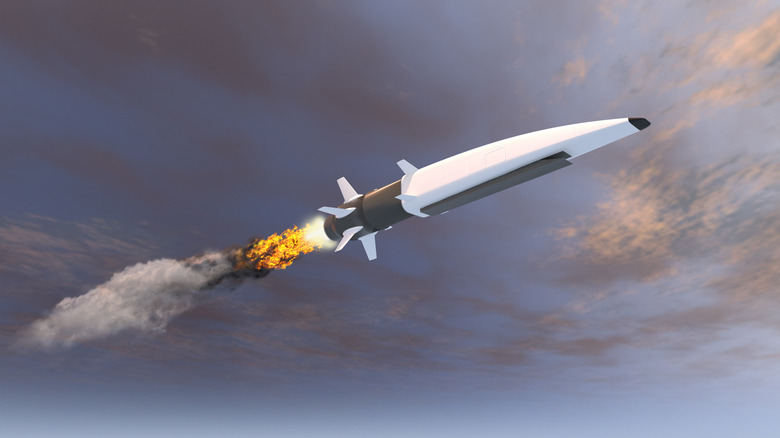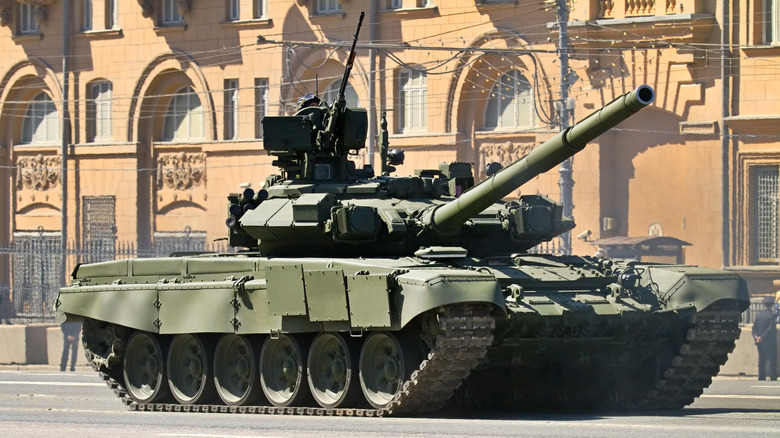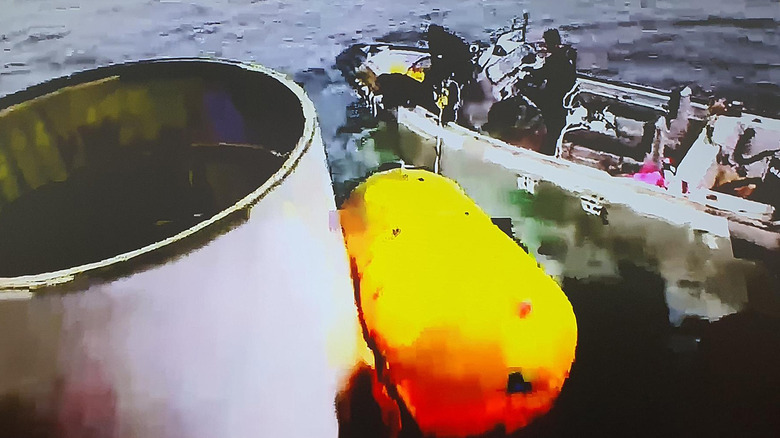
Guvendemir/Getty Images
Psychological warfare is a huge aspect of, well, warfare. If the enemy thinks you have the upper hand, they’re going to have a hard time overcoming that self-imposed handicap and fighting back. Fewer things put the fear into troops’ hearts more than thinking they are going up against a new piece of technology they can’t counter. Usually, the destructive power of these devices is as obvious as a gunshot, but sometimes, a military is instead firing blanks.
Almost every piece of military tech is designed to improve combat efficacy. Sometimes it’s a gun that shoots around corners without exposing the wielder, other times it’s a vehicle that fires actual lasers. Weapons like these change how wars are fought, but not every military invention is as useful — or usable at all. For instance, the U.S. military tried creating a camo pattern that could let soldiers blend into any environment. On the surface, universal camoflage sounds like an incredible invention that would only be possible in video games, partially because a such a suit was a major feature or gimmick of “Metal Gear Solid 4.” But when the military gave it a try, it turned out the naysayers were right. It didn’t work.
But the universal camo pattern was far from the only military invention that couldn’t live up to the hype — there are many more examples.
Hypersonic Missiles

Estt/Getty Images
Missiles are some of the most dangerous weapons on the planet. Not only can they carry devastating payloads, they are also capable of altering trajectory. Plenty of nations field anti-missile defense systems, but the theater of war is all about escalation. You launch a missile, I shoot it down until or unless you launch a missile I can’t shoot down.
Several years ago, Russian President Vladimir Putin declared his country was developing hypersonic missiles. One of the world’s fastest supersonic missiles is the BRAHMOS, which has a top speed of just under Mach 3, but Russia’s hypersonics will be able to eclipse Mach 20. Iran is also developing its own hypersonic missile.Why is this a big deal? Instead of carrying anti–anti-missile defensive measures, hypersonics can simply outrun incoming ordnance. It’s a solution as simple as it is dangerous, but only if it works.
According to engineers and physicists like David Wright and Cameron Tracy, the biggest hurdles hypersonic missiles will face won’t be EMP bursts or other missiles but general physics. The faster an object moves through a fluid, the more resistance it faces. This resistance, known as drag, turms kinetic energy to shock waves and thermal energy. Hypersonic missiles could potentially travel so fast that their own drag would threaten their integrity. Even if drag doesn’t literally shake hypersonic missiles apart, they won’t be particularly agile because of their intense speeds.
Thus, hypersonic missiles might not be the future of warfare they have been hyped as.
Universal Camouflage Pattern

Golbay/Shutterstock
Muhammad Ali’s quote “The hands can’t hit what the eyes can’t see” applies to more than just boxing. Camouflage is a crucial tool on any battlefield because enemy troops can’t riddle you with bullets if they don’t know where you are. However, as in the animal kingdom, camouflage must be designed with a specific environment in mind. Unless you’re an octopus or chameleon, universal camouflage isn’t exactly available.
The U.S. military has been working on camouflage since the 19th century, and as technology advanced, designers have used computers to create pixel-based designs since they confuse the brain. The Marine Corps made great use of this technique, and the U.S. Army wanted in on the idea, but they also wanted their camouflages to be more cost effective and able to blend into as many environments as possible. The Army’s solution was a Universal Camouflage Pattern. In theory, the design’s pixelated splotches of gray, beige, and green would disguise soldiers in woodland, desert, and urban environments. In practice, the pattern proved quite deadly — for their wearers, that is.
Because of how the Universal Camouflage Pattern’s pixels were laid out, and because the design lacked any black, it produced what is known as isoluminance. This optical illusion makes the human brain see numerous colors and patterns as a solid blob. As a result, Universal Camouflage Pattern made anyone who wore it look 2D when viewed against 3D surfaces.
Universal Camouflage Pattern did the exact opposite of camouflaging its users, which is not an ideal outcome when lives are on the line.
What Russia is using against Ukraine

Rusm/Getty Images
Propaganda can be a powerful tool. Portray your army as knights in shining armor and your enemies as a source of all evil, and you can often convince civilians to join your military in droves. Of course, eventually, facts get in the way of this narrative, especially when it comes to light that your troops are wielding tech that doesn’t exist.
If you pay attention to the news, you probably saw enough reports on Russian anti-Ukraine propaganda to last a lifetime. Russian state media has claimed it is invading Ukraine to “denazify” the country, and that many Ukranians are thankful for this violation of their borders. Moreover, many Russian ad campaigns show its military in a position of power with all the best weapons and body armor, which is one of the biggest lies of all.
In reality, forces engaged in the Ukrainian invasion are woefully underfunded. Instead of top-of the-line armor, Russian soldiers have reportedly been spotted in WWII helmets made look new and foam armor designed for paintball battles. And instead of med kits designed to treat bullet wounds, recruits are told to use tampons. And that’s just the equipment Russian soldiers actually receive. Communication has been relegated to unsecured walkie talkies — the kind you buy in a camping store — and soldiers have to paint over their guns to hide the fact that their weapons have all but rusted away.
If Russia wanted to succeed in its illegal invasion, it probably should have saved the money spent on propaganda and used it for weaponry instead.
The Littoral Combat Ship

Viper-zero/Getty Images
Every military vehicle is designed to serve a specific purpose on the battlefield. Sometimes they are supposed to replace older models, other times they are meant to excel in specific theaters of war. Regardless of purpose, if a vehicle can’t fill its intended niche, what was the point in claiming it could?
The littoral combat ship (LCS) was meant to be a “fast, agile, and networked surface combatant” that performed best in coastal waters, also known as littorals — hence its name. More importantly, each ship would revolve around modular segments that could be swapped out depending on missions and specific threats. Littoral combat ships were intended for theaters where larger ships couldn’t be used effectively, but they didn’t live up to expectations.
Problems began cropping up before these vessels were even completed. Production of littoral ships went over budget, but the seafaring service still wanted these ships, so it started a bidding war, and two companies were selected produce their own designs, Lockheed Martin and Austal Ltd. The end result, however, fell short. Despite being built to tackle a variety of targets, the littoral combat ships could only effectively attack small boats that lacked anti-ship capabilities. And in a twist of irony, the hull shapes of the Independence-class littoral ships restricted them from navigating narrow waterways and harbors.
Currently, all Freedom-class littoral vessels are scheduled for scrapping, and some aren’t even half a decade old. This decision should tell you everything you need to know about the littoral combat ship’s performance.
Active Denial System
When you hear the term “heat ray,” you might think of sci-fi weapons that burn targets to a crisp. Pop culture is full of heat weapons inspired by the concept, so it’s not hard to imagine what real-life heat rays could look and act like. Turns out it would be a weapon you can counter with a jacket or weather.
In 2010, the U.S. military sent a weapon known as the Active Denial System (ADS) to the front lines in Afghanistan in hopes that it would help stop civilians from being used by terrorists in crowds. The device was meant to cause discomfort likened to an “intolerable heating sensation” without lasting physical damage, let alone chance of death. According to over 10,000 tests, the worst fate anyone suffered was painful blisters — and one case of second-degree burns, but that was an alleged accident, according to Wired. Since the ADS had a range of over 500 meters, one would think it could have easily turned the tide of many battles, but it didn’t. It never saw combat.
The U.S. Military withdrew the ADS without ever using it. This decision is mysterious since tests seemingly demonstrated the ADS was extraordinarily effective at heating skin to painful levels without causing permanent damage. However, that might have been the problem: The ADS heated skin. Apparently, it wasn’t strong enough to penetrate thick clothes. Moreover, since the weapon relied on microwaves, any form of precipitation absorbed the rays and rendered them useless.
While the ADS’ concept is being recycled and refined to be smaller and more reliable, its first outing left the people who supported it feeling burned.
LED Incapacitator
Many movies feature futuristic weapons. For instance, cops in “Minority Report” wield “sick sticks” which cause anyone hit by them to vomit. The movie “Kick-Ass 2” ups the ante with its own “sick stick” that causes people to uncontrollably vomit and defecate. Of course, both weapons are completely fictional, but the Department of Homeland Security (DHS) tried designing a real version of the “sick stick,” only it was neither sick nor a stick.
In 2007, the DHS rolled out a prototype for the LED Incapacitator. This non-lethal “weapon” was shaped like a flashlight used rapidly flashing and shifting lights to overwhelm a target’s senses. According to reports at the time, the device temporarily blinded people and made them so sick they would vomit. It’s not much, but that opening would be all users needed to swoop in and apprehend their targets. Who could have predicted that focusing all the power of a disco ball into a flashlight could be so dangerous? Unfortunately, it’s all a matter of perspective. Literally.
According to Bob Lieberman, CEO of Intelligent Optics, the company that produced the LED Incapacitator, claims regarding the LED Incapacutator’s capabilities might have been overblown, specifically the belief that it can make victims blow chunks. Lieberman couldn’t recall a single time his company’s tests resulted in such a vomitous outcome. However he admitted that the LED Incapacitator could trigger epileptic seizures in anyone unfortunate enough to suffer from that susceptibility.
The LED Incapacitator was a victim of hype, but at the end of the day, it still works. Just don’t look point it at your eyes if you ever get your hands on one.
Predator Drone

Bloomberg/Getty Images
Unmanned Aerial Vehicles (UAVs) are largely seen as the next big evolution in air-based combat — fast, sleek, and most importantly lacking human pilots. Even if you lose a UAV, you won’t lose the any people. However, while UAVs are certainly useful for certain missions, in many instances they can’t outmatch planes with flesh and blood pilots.
General Atomics’ line of Predator drones are probably the most famous (or infamous) UAVs on the market. While they have effectively been supplanted by the more advanced Reaper drones, Predators still define decades of warfare in the Middle East. Whenever the U.S. military wanted to take out high-ranking members of al-Qaeda or the Taliban, they often sent in the drones. However, despite their body counts, these drones weren’t exactly apex predators.
On December 23, 2002, a Predator drone attacked an Iraqi MiG fighter. The drone lost. The battle consisted of the two planes trading Stinger missiles, but by the end of the short fight, it was clear that the drone wasn’t cut out for engaging live enemy pilots — or using Stinger missiles. However, Predator drones had even more fatal flaws yet to be uncovered. In 2009, U.S. soldiers discovered that Iraqi insurgents had managed to hack into live drone feeds using $26 worth of civilian-grade software, recorded countless hours of video, and stored them on laptops.
While strides are still being made, it’s unlikely UAVs will entirely replace live fighter jet pilots in the near future.
Deepfake Videos

Dmytro Larin/Shutterstock
Misinformation is a powerful tool that can start and end wars. Thanks to advances in technology, it’s getting harder to tell the difference between fact and fiction. You can’t even trust audio and video recordings these days unless they look really, really fake.
In March of 2022, a video of Ukrainian President Volodymyr Zelensky surfaced where he told Ukrainian soldiers to put down their weapons and surrender to Russian invaders. The video was, of course, a forgery. The head was too big and moved independently of the body; the resolutions and skin tones of the head and body didn’t match, and the voice was too deep. The video was what is known as a deepfake, a distortion of images and voice recordings to create fraudulent videos. It’s the same technology that created all the “Baka Mitai” meme videos in 2020, the only difference being that the memes were more convincing and entertaining.
It goes without saying that few if any Ukrainian soldiers fell for the President Zelensky deepfake, and the original video was quickly removed from the internet. While nobody knows for sure who created the deepfake or for what purpose, the running theory is that Russians created it in an attempt to trick Ukrainian soldiers and possibly sow dissent. If true, those responsible only succeeded in making Russia look bad.
North Korean Spy Satellite

Handout/Getty Images
Not all military tech has an active role on the battlefield. Spy satellites are one such example as they are invaluable tools for gathering intel. Many countries with a large global presence have launched satellites into orbit, but North Korea isn’t one of them. And by the look of things, it won’t for a while, but not for lack of trying.
As of late, North Korea has been ramping up its missile tests, and on May 31, 2023, one of the country’s launches sputtered and dropped into the Yellow Sea, about 125 miles of the island of Eocheongdo. This went over poorly as North Korea is has countless sanctions restricting its missile capabilities — which hasn’t stopped them carrying on building the program. Alas, North Korean officials came clean with a statement that it wasn’t a test missile but rather a delivery vehicle for a spy satellite.
The South Korean Navy salvaged the wreckage first, but while this (its sixth attempt to put a satellite up) launch demonstrated North Korea has a ways to go until it can put a satellite in space, it was still enough to scare the residents of neighboring countries. Just imagine what would have happened if the North Korean missile had been carrying something more radioactive than a satellite.
North Korean Missiles

3dsculptor/Getty Images
As you may have guessed, North Korea has pretty big aspirations, at least when it comes to military prowess. The nation has one of the largest militaries in the world despite its relatively small population size, and North Korea has been trying to expand its nuclear capabilities too. Thankfully, officials have yet to nail down a reliable delivery service.
These tests carried out over the last decade have luckily ended in failure, including launches on March 16, 2022 and November 3, 2022 launches. Both missiles, which were Intercontinental Ballistic Missiles (ICBMs), self-destructed shortly after takeoff. Many countries, quite understandably, called for further sanctions against North Korea in the aftermath.
While North Korea is steadily stockpiling an armory of nuclear weapons, in spite of those strict sanctions, it is having trouble producing a reliable delivery method. While the country’s smaller missiles have tested successfully, its nuclear-capable ICBMs don’t have as stellar a track record. While one of North Korea’s latest ICBM tests, which occurred on July 11, 2023, that result wasn’t necessarily a surprise given the nation has trouble rocketing satellites into orbit (as noted earlier in this article). Since North Korea is still working on its missiles, only time will tell if North Korean leader Kim Jong Un’s nuclear dreams will ever live up to the hype. If so, it would be a scary day for the intended target.


